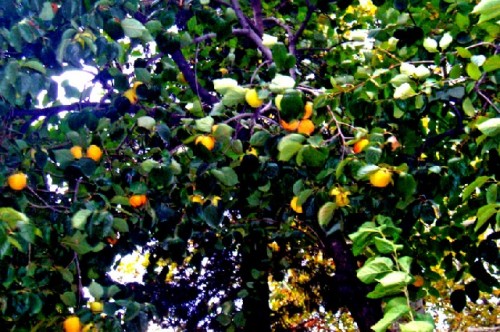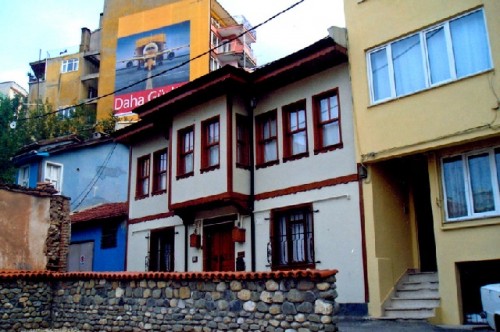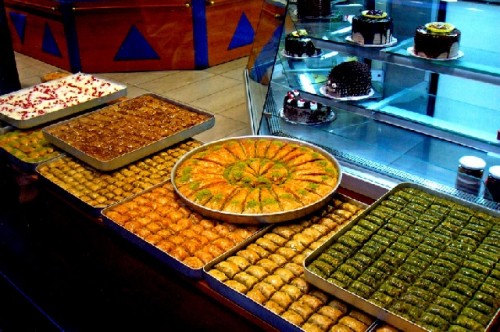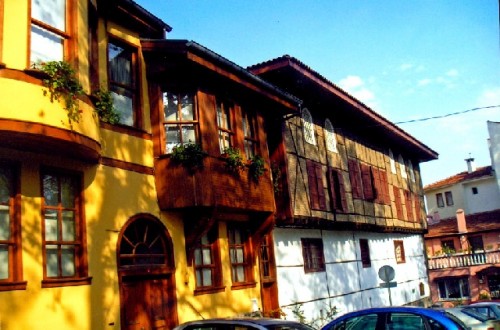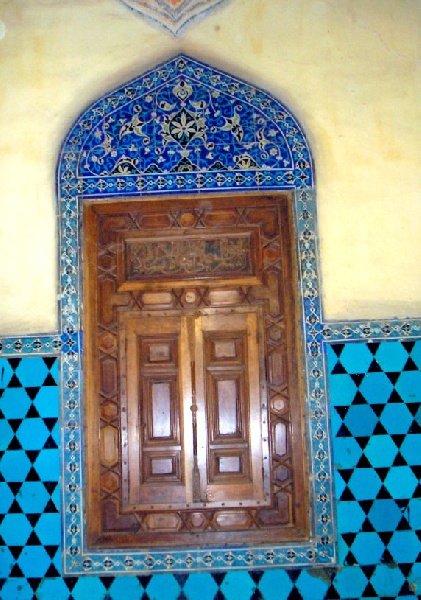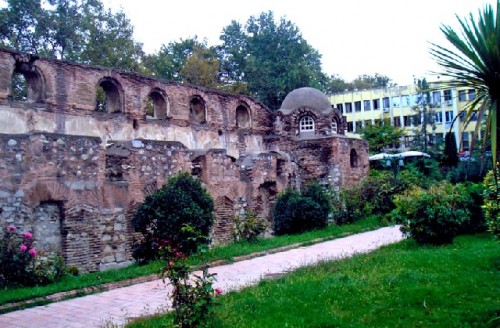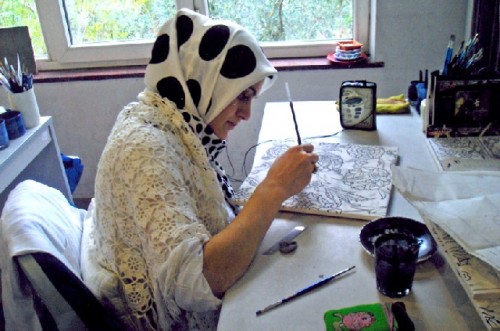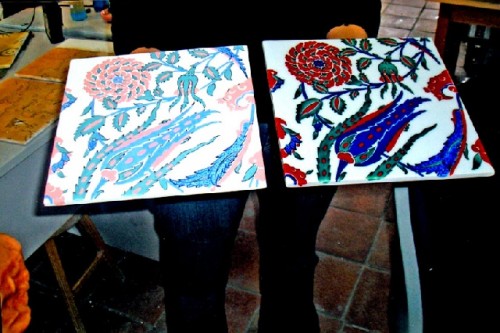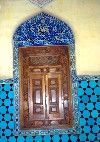Travels in Turkey Six
Visiting the cities of Bursa and Iznik
By: Zeren Earls - Jun 13, 2007
Bursa
Called Prusa by the Byzantines, Bursa is an old city that grew to importance with its thermal baths and silk trade during Justinian's time. The importation of silkworms and the establishment of looms began an industry that survives to this day. Bursa was the first capital of the Ottoman Empire, and as such renowned for its royal mosques, markets and covered bazaar. The city, Turkey's fifth largest, lies on the slopes of Uludag (Mount Olympus), a winter ski resort and summer hiking center.
Our exploration began on foot near our hotel to avoid rush hour traffic. We visited the Mosque of Sultan Murat I (1366). Built in rows of brick and stone, it has a second story medrese and a single minaret and is unique in its plainness, devoid of any tile work. It accommodates 2500 people at a time and has a prayer balcony for the Sultan. Across from the mosque is the Sultan's tomb, along with those of a son and grandson.
At one of Bursa's old homes, restored as a restaurant, we stopped for tea – a time-honored Turkish tradition. Then we walked the cobbled streets, admiring the architecture of Ottoman homes with bay windows. Gazing at the array of syrup-drenched sweets in shop windows, watching people line up at bread ovens on the way home and marveling at two policemen managing rush hour congestion at a traffic circle, we ended our tour.
In the morning we drove about 1000 meters up Uludag to see the 599-year-old sycamore tree. Traditionally planted in every village square, this majestic one, secure in its position by a spectacular view of the mountainside, welcomed passers-by with outstreched sturdy arms. Similarly extended on the northern foot of the 2600-meter-high mountain believed to be a dwelling for the Olympic gods is Bursa. It is surrounded by chestnut, walnut, peach and cherry trees, and is famous for its candied chestnuts and big aromatic peaches.
Returning to the city, we visited several of the more-than-one-hundred mosques that dot its landscape. Muradiye, the first Ottoman mosque complex (1366-1386) to include buildings for social services, has a bath, public kitchen, fountain and medrese on beautiful grounds. Ulu Cami (the Great Mosque), completed in 1399, is impressive in size. Twelve great columns support twenty domes intended to create a sense of God's grandeur. It has a central marble pool and ablution fountain. Light comes in from the windows of the domes. The minber (pulpit) is made of carved walnut. We were unable to see the famed Yesil Cami (Green Mosque) due to restoration work.
A restored Ottoman home is Bursa's ethnographic museum. The different rooms show the men's receiving and living areas and the women's quarters, where mannequins clad in silk sit embroidering or rocking a cradle. Impressive jewelry and costumes complete the collection. Afterwards for lunch we enjoyed iskender kebap: thin slices of gyro served on pita bread with garlic yogurt. This dish, named after Alexander, is a local specialty.
Following a brief tour of Koza Han (the Cocoon Caravanserai) and the covered bazaar, Evin left us to wander on our own. Delighted with this opportunity, I wandered in and out of the little shops that lined the two stories of the Han. Much to my surprise I discovered that many of the silk scarves and shawls displayed were from China or India. I managed to purchase two locally made scarves, one with a sultan's insignia motif and the other from raw silk, the color of pomegranate. The reasonable prices followed compliments on my fluency in Turkish! My time in the covered bazaar and the market for local specialties like towels and cutlery was brief. Bayram (the holiday following Ramadan) was approaching, and the market resembled the mayhem of Christmas shopping. I took a dolmus ("stuffed") taxi, which only starts when filled with passengers, back to the hotel.
In the morning we left Bursa to head back to Istanbul via Iznik. As we passed the University Hospital, signs displaying its eye surgery and cardiac arrhythmia units, underlined the city's importance in health care beyond its thermal waters. Stands of locally raised onions, tomatoes and quinces interspersed with boxes of candied chestnuts and floss halva reminded us that there was more to Bursa, despite the factory-lined highway. Uludag shrouded in fog formed a magical backdrop to the multifaceted city.
Traveling north to Gemlik on the bay, we drove by olive groves, fields of ornamental flowers and tree nurseries. Near the Gemlik shipyard we turned east, skirting Iznik Lake. The approach to Iznik was picturesque: one-story homes amidst fruit trees, tea gardens with checkered tablecloths and cypresses lined the lakeside. Homes made of a mixture of old and new mud bricks strengthened by wooden armatures with small windows dotted the hillside. Women, heads covered, on tractors signaled progress and prosperity.
Iznik
According to legend this ancient city may have been founded around 1000 BC. Lysimachus, one of Alexander's generals, reestablished it in 316 BC and named it after his wife Nikaea. It became the capital of Bithynia and in 74 BC was gifted to the Roman Empire. With the rise of Constantinople, Nicaea took on new importance, becoming the venue for the first and last Ecumenical Councils, meetings of representatives of all Christian churches. In 1080 the Seljuks captured it, followed by the Ottomans in 1331.
Walls that have been stormed by many invaders still enclose most of the present town. The Haghia Sophia Church built by Justinian is now a museum with a minaret, having gone through several incarnations. It was converted into a mosque about 1331 and restored by the architect Sinan in the 16th century. Its most recent destruction was during the war between Greece and Turkey in 1922. The building is significant as the meeting place of the Seventh and last Ecumenical Council in 789.
The Archeological Museum has ancient pots, a good collection of old Iznik ceramics, jewelry and early coins, beginning with copper, silver, gold and nickel. The tile history of the city dates back to the 14th century, when ceramic masters were brought from Persia. The craft developed with three hundred workshops during Sultan Süleyman's time in the 16th century. The beautiful tiles are distinguished by their mastery of design and color, especially a tomato red that has been difficult to replicate.
Many small tile shops surround Iznik's historic sites. I dropped in one to look. My eye was caught by a scarf with distinctively Turkish hand-embroidered edges on the shelf. Anatolian women express emotions through the colors and motifs they depict in this unique craft. The shop owner said the scarf was from his wife's dowry and that he had fifteen of them. After keeping them in a chest for 25 years, she had no longer found them useful and had given them to him to sell. Her daughters did not want them; she herself had moved onto modern head covers. Seeing the life story of this woman unravel in these beautiful scarves, I alerted my travel mates to the lucky find. Touched by the woman's story, one person made a generous donation and gifted the scarves to the rest of the group. Amazed at their fortune, the shopkeeper promised to give the money to his wife.
The Iznik Foundation is a non-profit organization founded to revive the ancient art of ceramic tiles. It is open to visitors and serves lunch with advance notice. The celeriac appetizer in olive oil and the milk pudding flavored with mastic deserves mention. We toured the workshops, beginning where clay is mixed with quartz and glass and poured into molds, followed by firing and sanding until smooth. Pricking a drawing with a straight pin and rubbing it with powdered charcoal transfers the design onto a tile.
After the contours are drawn the design is filled in with color, its order determined by the thickness of the glaze. Copper oxide for turquoise is applied first, iron oxide for red last. Once the glazing is complete, liquid glass is poured over the tile before the final firing. The artisans, all women, were working on a large mural, a commission for the naval academy. We culminated our tour in the show room. I bought a star-shaped turquoise tile, a piece from a Seljuk border design that I could not afford in its entirety.
The trip was coming to an end. Our bus headed to Yalova to catch the car ferry to Istanbul. We had a final glass of tea in an outdoor garden while we waited for the ferry. Shortly after boarding, minarets lit up signaling iftar. Attendants passed out dates to passengers. (Ending the fast with a date, a holy food, is favored in Islam). As we approached Istanbul, lights studded its hills; old mosques glowed like gold crowns in the nightscape, a spectacle only matched by the stars overhead.
My comments reflect my love of Turkey, a country rich in beauty, history and culture that are hard to match. We passed through five of its seven geographic regions, each different not only in climate, but also in folklore, cuisine and local color. As someone who has lived outside the country for a very long time, I was able to observe it from the perspectives of both outsider and insider with sensitivity to its development as well as its problems. While I rejoice over its economic growth and progress in general, I cannot be oblivious to its slide to the right. This is most visible in the way people dress compared to the days of my youth. A recent survey indicates that more people identify themselves as Muslim first and Turkish second; several years ago the opposite was the case.
The stumbling blocks the European Union puts up to keep Turkey from joining is going to result in a loss not only for Europe, but for the world at large. The concessions the EU expects from Turkey are a matter of time. Ultimatums have been shown to be ineffective policies, as opposed to diplomacy and patience. I hope those leaders against Turkey's joining the EU come to their senses soon and go back to the negotiating table.
A land bridge between east and west, north and south throughout history, there are eighty digs currently going on in Turkey. A trove for archeologists, each dig reveals a different layer of history. This is one country to which "been there, done that" does not apply. Deeply rooted in the East culturally, but always looking west as a democratic and secular Islamic country, it never fails to fascinate.

